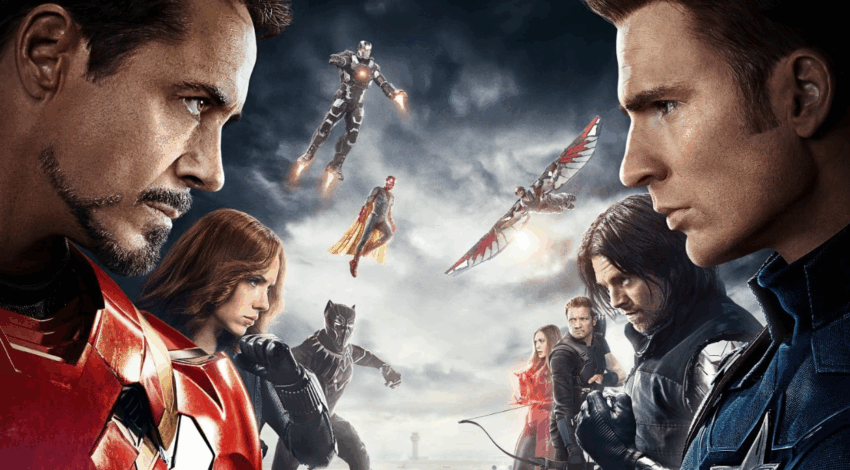Last week, we looked at how the buildup to an emotional moment is one of the most effective ways to give that moment meaning when it comes. But this principle also works in the other direction, as well. Simply put, readers will subconsciously judge the significance of something based on its impact on the rest of the work. The consequences of those moments in many ways determine how the moment itself is perceived.
Because consequences by definition come in the aftermath of an emotional moment — whether that’s an important decision, an unexpected revelation, or a passionate promise between characters — we’re going to be looking at Captain America: Civil War in particular, but also pulling from the context of the previous two Captain America movies to show how the emotional moments (especially in The Winter Soldier) had far-reaching consequences that ultimately gave those moments impact.
The Winter Soldier and Civil War
In America during the 1940’s, Steve Rogers and his childhood best friend Bucky Barnes joined the war effort, helping the Allies challenge Nazi expansion in Europe. Steve was selected for a special program that allowed him to receive a super soldier serum, which gave him almost inhuman strength and resilience. His presence on the battlefield became not only practical, but also a moral support, as well. He dons his iconic alter ego, Captain America, to rally forces behind America’s war effort.
But despite his fame, success, and strength, tragedy strikes when he loses Bucky in battle after he falls from an incredible height and is lost in the valley below. Later, Steve himself is presumed dead when he sacrifices himself by flying a bomber capable of killing millions into the Arctic.
But decades later, SHIELD agents recover Steve’s frozen body and are able to revive him.
Hesitantly, Steve rejoins public life, now defending innocents from far greater threats than even the Nazis had been as he tries to find his new role in a world that has moved on without him. He becomes a SHIELD agent, and is sent on numerous missions to take out HYDRA operatives. But of all of HYDRA’s agents, the most formidable is the Winter Soldier. With super-human strength and a decades-long history of nearly-impossible assassinations, even Steve is significantly challenged when the Winter Soldier is sent to kill him. But everything changes when Steve discovers that Bucky is the Winter Soldier. Steve eventually learns that Bucky survived the fall, was recovered by HYDRA, and then tortured and brainwashed into becoming the Winter Soldier. Between missions, he’s been frozen much like Steve was, often for years or even decades on end.
The moment that Steve realizes who the Winter Soldier is for the first time is both highly emotional and comes with massive consequences. Even though the Winter Soldier has been ordered to kill Steve and his friends and has succeeded in shooting one of them, Steve decides he will stop at nothing to redeem Bucky and remind him who he is. By the end of the movie, he’s proven he’s willing to sacrifice his own life, surrendering his weapons and defenses to be beaten until he dies if that’s what it takes to bring Bucky back.
And, miraculously, it does.
Bucky comes back, rescues Steve, and escapes off the grid from the law enforcement who are now hunting him for his numerous crimes. His story continues in Civil War, when government agents are to hunt him down. To them, he’s nothing more than a threat to be eliminated. To Steve, he’s a friend he’s willing to die for, even as he learns more and more about what he’s been doing since they fought side-by-side in World War II — including the fact that he personally killed both of Tony Stark’s parents.
While many of Steve’s allies have signed the Sokovia Accords, in which they agreed to use their powers only at the order of the government, Steve has not, meaning he’s working alone, won’t have much backup, and will be arrested for violating the Accords if he’s caught. The government eventually decides that Steve must be stopped, as well as Bucky, and so they send Tony with the Avengers who agreed to the Accords to take him out. Steve knows he needs allies, and so he finds the few Avengers who are left to help defend him and Bucky.
Thus we get the setup for Civil War.
Things are plunged into even further chaos when Tony discovers who killed his parents. Aggression runs so high that Steve comes to the point of killing Tony to protect Bucky, and although he stops just in time, irreparable damage is done to the team that once lived and died for each other.
These two movies, when taken together, illustrate an absolutely crucial principle for writing emotional scenes:
Consequences create impact.
Consequences Create Impact
One of the biggest things you can do to show your audience that your emotional moments matter is have their impact stretch far past just the scene they take place in, and instead touch moments that are pages and pages — and possibly whole books — in the future.
The moment that Steve realized who the Winter Soldier was came with such impact because this revelation wasn’t trivial in consequences. Steve proved just by the end of the movie that he was literally willing to give up his own life because of this discovery. And if you take a greater scope of the MCU as a whole, you can see this has even farther-reaching consequences.
Bucky’s identity as the Winter Soldier is one of the biggest pieces of the wedge that is driven between Steve and Tony and the respective members of their teams. It’s not the only cause of the split between them, but it is an undeniable part of it. In other words, Steve’s realization didn’t just affect him, his choices, and his fate, but also his relationships, his friends, and their freedom. Many of his allies are ultimately imprisoned for helping him, and even though he’s able to break them out, they spend the following years on the run from the government they once fought for. It takes years of building trust and ultimately an intergalactic threat for those Avengers to work with the government again as recognized keepers of the peace.
One of the fastest ways emotional moments can seem trivial is when they don’t affect the future. When a whole cast of characters brush off a betrayal like it’s no big deal, ignore the loyalty they expressed in their impassioned speech just a few pages ago, or grieve a friend’s death briefly and move on, these moments lack impact. The same thing will happen if your villain’s big plan is forgotten almost the moment it’s enacted, or your characters’ relationships remain static even as they make bold sacrifices and strong promises to protect each other.
While you want to make sure you don’t come up with contrived consequences to stretch out drama that’s essentially already over, in real life actions often have massive and unexpected consequences, and you break your readers’ suspension of disbelief when your character’s actions do little to change the future.
This truth is the other side of the coin of our last principle: buildup makes it matter. Just like intentional setup before an emotional scene gives it weight, intentional and far-reaching consequences following that scene create an impact on both your readers and characters that they aren’t likely to forget. When the choices and actions of your characters have far-reaching, permanent effects on their identity, relationships with others, and the world around them, your readers will be confident that you write emotional scenes with intention. If you want your emotional moments to truly leave an impression on your readers, make sure they also impact other elements of your book, and your readers will remember the power of those moments for as long as your characters do.



Let us know in the comments:
What other meaningful moments have you noticed hit hard because of the consequences that follow? What consequences are a result of the emotional moments in your current WIP?


Hi! My name is Mara, and I’m a Christian artist, violinist, and blogger. I remember the day that I decided that I would learn something new about what makes a good story from every book I picked up — whether it was good, bad, or a mixture of both. I use this blog as a way of sharing some of the tips and tricks I’ve learned, and highlight which books, cartoons, and movies have taught me the most about writing an awesome story.

